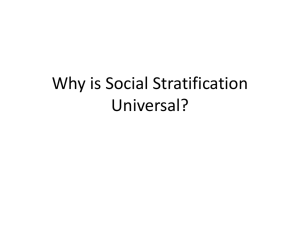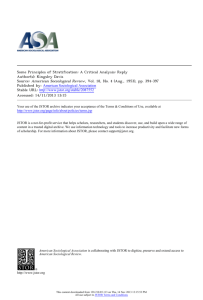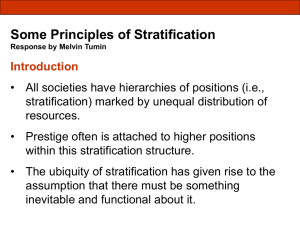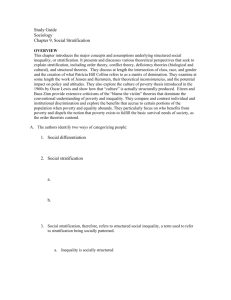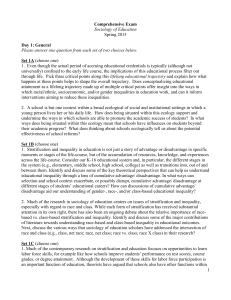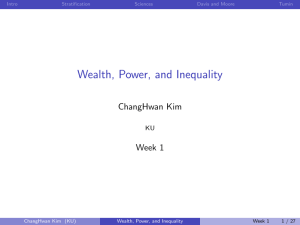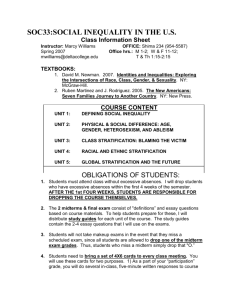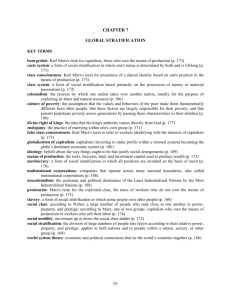Davis_1953_ASR_reply_to_Tumin
advertisement
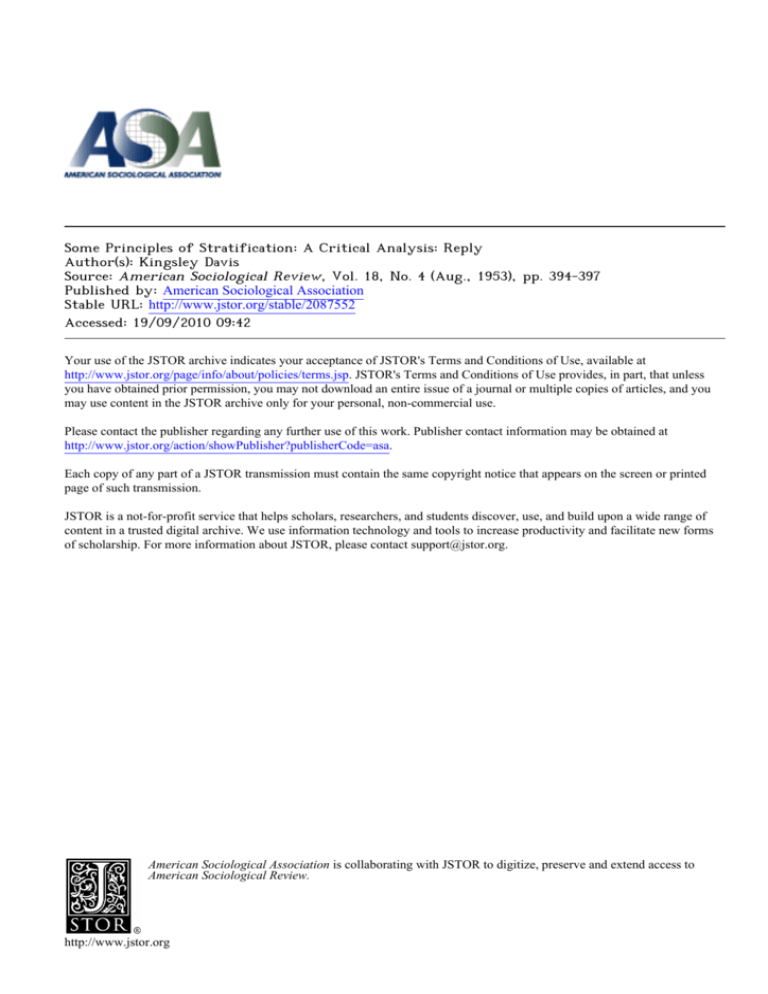
Some Principles of Stratification: A Critical Analysis: Reply Author(s): Kingsley Davis Source: American Sociological Review, Vol. 18, No. 4 (Aug., 1953), pp. 394-397 Published by: American Sociological Association Stable URL: http://www.jstor.org/stable/2087552 Accessed: 19/09/2010 09:42 Your use of the JSTOR archive indicates your acceptance of JSTOR's Terms and Conditions of Use, available at http://www.jstor.org/page/info/about/policies/terms.jsp. JSTOR's Terms and Conditions of Use provides, in part, that unless you have obtained prior permission, you may not download an entire issue of a journal or multiple copies of articles, and you may use content in the JSTOR archive only for your personal, non-commercial use. Please contact the publisher regarding any further use of this work. Publisher contact information may be obtained at http://www.jstor.org/action/showPublisher?publisherCode=asa. Each copy of any part of a JSTOR transmission must contain the same copyright notice that appears on the screen or printed page of such transmission. JSTOR is a not-for-profit service that helps scholars, researchers, and students discover, use, and build upon a wide range of content in a trusted digital archive. We use information technology and tools to increase productivity and facilitate new forms of scholarship. For more information about JSTOR, please contact support@jstor.org. American Sociological Association is collaborating with JSTOR to digitize, preserve and extend access to American Sociological Review. http://www.jstor.org 394 AMERICAN SOCIOLOGICAL REVIEW scarcity or abundance of available talent has been indicated as a principal source of possible variation. The extent to which the period of training for skilled positions may reasonably be viewed as sacrificial has been called into question. The possibility has been suggested that very different types of motivational schemes might conceivably be made to function. The separability of differentials in power and property considered as resources appropriate to a task from such differentials considered as rewards for the performance of a task has also been suggested. It has also been maintained that differentials in prestige and esteem do not necessarily follow upon differentialsin power and property when the latter are considered as appropriate resources rather than rewards. Finally, some negative functions, or dysfunctions, of institutionalized social inequality have been tentatively identified, revealing the mixed character of the outcome of social stratification, and casting doubt on the contention that Social inequalityis thus an unconsciously evolved device by which societiesinsure that the most important positions are conscientiously filled by the most qualifiedpersons.8 8 Davis and Moore, op. cit., p. 243. REPLY KINGSLEY DAVIS Columbia University Tumin's critique, almost as long as the article it criticizes, is unfortunately intended not to supplement or amend the Davis-Moore theory but to prove it wrong. The critique also sets a bad example from the standpoint of methodology. Nevertheless, it does afford us a meager opportunity to clarify and extend the original discussion. The latter, limited to eight pages, was so brief a treatment of so big a subject that it had to ignore certain relevant topics and telescope others. In the process of answering Tumin, a partial emendation can now be made. GENERAL CONSIDERATIONS Our critic seems to labor under four major difficulties, two of a methodological and two of a substantive character. First, he appears not so much interested in understanding institutionalized inequality as in getting rid of it. By insinuating that we are "justifying" such inequality, he falls into the usual error of regarding a causal explanation of something as a justification of it. He himself offers no explanation for the universality of stratified inequality. He argues throughout his critique that stratification does not have to be, instead of trying to understand why it is. Our interest, however, was only in the latter question. If Tumin had chosen to state our propositions in our own words rather than his, he could not have pictured us as concerned with the question of whether stratification is "avoidable." Second, Tumin confuses abstract, or theoretical, reasoning on the one hand with raw empirical generalizations on the other. Much of his critique accordingly rests on the fallacy of misplaced concreteness. Our article dealt with stratified inequality as a general property of social systems. It represented a high degree of abstraction, because there are obviously other aspects of society which in actuality affect the operation of the prestige element. It is therefore impossible to move directly from the kind of propositions we were making to descriptive propositions about, say, American society. Third, in concentrating on only one journal article, Tumin has ignored other theoretical contributions by the authors on stratification and on other relevant aspects of society. He has thus both misrepresented the theory and raised questions that were answered elsewhere. Fourth, by ignoring additions to the theory in other places, Tumin has failed to achieve consistency in his use of the concept "stratification." The first requirement, in this connection, is to distinguish between stratified and nonstratified statuses. One of the authors under attack has shown the difference to hinge on the family. "Those positions that may be combined in the same legitimate family-viz., positions based on sex, age, and kinship-do not form part of the system of stratification. On the other hand those positions that are socially prohibited from being combined in the same legal family-viz., different caste or class positions-constitute what we call stratification."'l This distinction is basic, but in addition it is necessary to realize that two different questions can be asked about stratified positions: (a) Why are different evaluations and rewards given 1 Kingsley Davis, Human Society, New York: Macmillan, 1949, p. 364. 395 REPLY to the different positions? (b) How do individuals come to be distributed in these positions? Our theory was designed to answer the first question by means of the second. But much confusion results, as illustrated by Tumin's ambiguities, if the term "stratification" is used in such a way as to overlook the distinction between the two. THE SPECIFIC CRITICISMS It will be seen that these four difficulties plague Tumin throughout his remarks and lead to much obfuscation. In answering his criticisms, we shall follow his sequence in terms of the propositions attributed to us. 1. Differential Functional Importance of Positions. Tumin criticizes the idea of unequal functional importance on the grounds that the concept is unclear, unmeasurable, and evaluative, and that other systems of motivation are conceivable. The latter point is irrelevant, since the proposition in question says nothing whatever about motivation. So is the remark about "value-laden criteria," since no such criteria are advanced by us. As for the difficulty of measuring functional importance, we stated this before Tumin did, but he does not elect to discuss the two criteria suggested in our article. The difficulty of exact empirical measurement does not itself make a concept worthless; if so we should have to throw away virtually all theoretical concepts. Rough measures of functional importance are in fact applied in practice. In wartime, for example, decisions are made as to which industries and occupations will have priority in capital equipment, labor recruitment, raw materials, etc. In totalitarian countries the same is done in peacetime, as also in underdeveloped areas attempting to maximize their social and economic modernization. Individual firms must constantly decide which positions are essential and which not. There is nothing mystical about functional importance. Tumin points out that the unskilled workmen in a factory are as important as the engineers. This is of course true, but we have maintained that the rating of positions is not a result of functional importance alone but also of the scarcity of qualified personnel. Any concrete situation is a product of both. It requires more capital to train an engineer than to train an unskilled worker, and so engineers would not be trained at all unless their work were considered important. Actually Tumin does not deny the differential functional importance of positions. He disguises his agreement with the proposition by tendentious argumentation. 2. The Strangulation of Talent by "Stratification." Tumin's objection to the idea of a scarcity of trained and talented personnel rests on the argument (a) that societies do not have a "sound knowledge" of talents in their populations and (b) that stratification interferes with, rather than facilitates, the selection of talented people. The first point is inconsequential, because a selective system-e.g., organized baseball-does not require a pre-existing knowledge of talent to be effective. The second point is crucial, but Tumin strangely fails to refer to a later treatment of this very problem by Davis.2 In introducing the problem, Davis says: "One may object to the foregoing explanation of stratification [as contained in the Davis-Moore article] on the ground that it fits a competitive order but does not fit a non-competitive one. For instance, in a caste system it seems that people do not get their positions because of talent or training but rather because of birth. This criticism raises a crucial problem and forces an addition to the theory." The addition takes the following form: The theory in question is a theory explaining the differential prestige of positions rather than individuals. Even though a high-caste person occupies his rank because of his parents, this fact does not explain the high evaluation of the caste's position in the community. The low estate of sweeper as compared with priestly castes cannot be explained by saying that the sons of sweepers become sweepers and the sons of Brahmins become Brahmins. The explanation of the differential evaluation of strata must be sought elsewhere, in the survival value of drawing qualified people into the functionally most important positions. But since this is not the only functional necessity characterizing social systems, it is in actuality limited by certain other structures and requirements. Among the latter is the family, which limits vertical mobility by the mechanism of inheritance and succession. The family's limiting role, however, is never complete, for there is some vertical mobility in any society. Thus the selective effect of the prestige system exists in its pure form only abstractly, not concretely; and the same is true of the inheritance of status. Consequently, to say that in a given society there is partial inheritance of high positions is not to deny that at the same time the prestige system is operating to draw capable people into these positions. One source of confusion in this argument is the ambiguity, mentioned above, of the term "stratification." On the one hand it is used by us to designate the institutionalized inequality 2 Human Society, pp. 369-370. 396 AMERICAN SOCIOLOGICALREVIEW ot rewards as between broad strata.6 Un the other hand, it is used (as Tumin does implicitly) to mean the inheritance of class status. With the latter definition, of course, the idea that stratification contributes to upward mobility is incongruous. One cannot expect a theory designed to account for the universal existence of institutionalized inequality as between positions to be, at the same time, an explanation of the inheritance of class status. However, it is possible to extend the theory by combining with it a general analysis of the family's articulation with the differential reward system in society. This has been done by Davis, and the result is that one can understand the combined existence in the same society of (a) a differential ranking of stratified positions, (b) a certain amount of vertical mobility, and (c) a certain amount of inheritance of status. It is this extension of the theory that Tumin ignores. thinking in terms of professional training, never once mentions the onerous necessity of studying. It is unfortunately true that most individuals regard hard study as burdensome, and it is something that the family cannot do for them. Many youths are unwilling to make this sacrifice and also many are incapable of doing it well enough to succeed. There are, however, many other kinds of hurdles to high position that would discourage an individual if it were not for the rewards offered. So difficult is it to get enough qualified personnel in good positions that the modern state undertakes to bear some of the costs, but it cannot bear them all. 4. Alternative Motivational Schemes. Our critic contends that there are "a number of alternative motivational schemes" as efficient as differential rewards in motivating people to strive for important positions. Actually he mentions three: joy in work, sense of social service, and self interest. The third is obviously a 3. The "No Sacrifice" Criticism. ringer. Concerning it he asks, "To what extent Tumin contends, in effect, that no differential could the motivation of 'social duty' be instirewards are necessary to induce individuals to tutionalized in such a fashion that self interest qualify for functionally important positions, be- and social interest come closely to coincide?" cause they make no "sacrifices." In support of The answer is that such coinciding is not only his view he says (a) that the family often possible but is actually accomplished-and our makes the sacrifice for the offspring, (b) that theory of social inequality explains how. This the loss of earning power during the training leaves, then, only two alternatives that offer period is negligible, and (c) that the prestige any possible criticism of our views. In the eight-page article under attack, it was menduring the training period is high. But point (a) confirms rather than denies tioned that one consideration is the unequal the theory. It makes no essential difference that pleasantness of activities required by different the family assumes some of the burden of positions, but space did not allow us to follow training; the fact is that there is a burden. out the implications of this fact. The truth is The differential ability of families to make such that if everybody elected to do just what he sacrifices of course comes back to the role of wanted to do, the whole population would wind the family in limiting competition for status, up in only a few types of position. A society which has already been discussed. The claim could not operate on this basis, because it reunder point (b) that the loss of earning power quires performance of a wide range of tasks. during training is more than made up in the Surviving societies therefore evolve some sysyears following again confirms the theory, for tem of inducements over and above the joy of we have said there is a differential reward for work which motivates people to do what they those attaining functionally important posi- would otherwise not do. Finally, as for the tions. As for point (c), the fact that the trainee sense of social service, any sociologist should may enjoy a standard of living higher than that know the inadequacy of unrewarded altruism of his already working age peers comes back as a means of eliciting socially adequate behavior. It must be remembered that the differto the family's status, already discussed. Nor ential rewards characterizing the status scale does the claim that the psychic rewards are are not all material; they also lie in the good high during training offer any objection to the and expectations of others and in the opinion theory, because these psychic rewards are self-satisfaction at having stood well of feeling mainly a reflection of the anticipated rewards in others' eyes. No one will deny that joy of of an ultimately high status to be attained work and a sense of social service are actual through training. It is amusing that throughout motives, any more than one will deny the his discussion of "sacrifice" Tumin, though reality of the desire for esteem (in contrast to prestige) but in any society they are supple3 K. Davis, "A Conceptual Analysis of Stratirather than- alternative to the posimentary fication,"AmericanSociologicalReview, 7 (June, tional reward mechanism. 1942), pp. 309-321. COMMENT 5-6. Types of Rewards. The Davis-Moore article mentioned a rough tripartite classification of types of rewards occurring in stratified positions. Tumin says these may be unequally employed, that one society may emphasize one type more than another. This is true; we said nothing to the contrary. Tumin goes on to say that societies give approval to behavior that conforms with norms. This we certainly never disputed; indeed, in connection with positions, Davis has given a name to it-esteem, the kind of approval that comes with the faithful fulfillment of the duties of a position.4 The approval that comes with having a position, i.e., approval attached to the position and not to the degree of faithfulness in performing its duties, is called prestige. Whatever the words used, the distinction is important, but Tumin has confused the two. A social system, though it certainly utilizes esteem, is not entirely built on it, because there must be motivation not only to conform to the requirements of positions held but also to strive to get into positions. Esteem alone tends to produce a static society, prestige a mobile one. Tumin's statement that the position of the parent vis-a-vis the child is not part of the stratified system is true, but it agrees perfectly with Davis' distinction between stratified and non-stratified statuses, already mentioned as an essential part of the theory overlooked by Tumin. 7. Inevitability and Disfunctionality. As the grand climax of his restatement of our views, Tumin has us concluding that social inequality is inevitable in society. Let it be repeated, we were not concerned with the indefinite or utopian future but with societies as we find them. No proof or disproof of a proposition about inevitability is possible. As "evidence" of his view of inevitability, Tumin hopes to see 4"Conceptual Analysis of Stratification," loc. cit., pp. 312-313; Human Society, pp. 93-94. 397 a society based on "the tradition that each man is as socially worthy as all other men so long as he performs his appropriate tasks conscientiously." But this is, once again, the idea of a society based exclusively on esteem. The question would still remain, how do people in the first place get distributed in their different positions with their "appropriate tasks?" One can hardly criticize a theory by ignoring the problem with which it deals. Tumin goes on to point out ways in which stratification is disfunctional. In most of what he says, however, "stratification" is being used in the sense of inheritance of status. In so far as his assertion of disfunctionality is true, then, the culprit is the family, not the differential positional rewards. He also mentions unfavorable self-images, but the disfunctionality of these is not clear, because an unfavorable selfimage may be a powerful stimulus to competitive and creative activity. The same comment can be made about the alleged disfunctionality of class conflict. Incidentally, in this part of his critique Tumin makes pronouncements of functionality with firm confidence, although in the early part he doubted the functionality could be determined. The truth is that any aspect of society is functional in some ways and disfunctional in others. Our theory was designed to suggest some of the ways in which institutionalized positional inequality contributes to societies as going concerns. Otherwise it seems difficult if not impossible to explain the universal appearance of such inequality. Excrescencies and distortions certainly appear, but they do not completely negate the principle. Tumin's analysis of the disfunctions is unsophisticated because of his confusion as to what it is that has the disfunctions, because of his uncritical concept of function, and because of his lack of any clear notion of a social system as an equilibrium of forces of which the stratified positional scale is only one. COMMENT E. MooR PrincetonUniversity WILBERT I generally concur with Professor Davis's reply, which is somewhat more comprehensive than the comments I had prepared independently. However, I should like to emphasize that there is no reason to deny to Professor Tumin the right and even the propriety of a theoretical approach to an equalitarian system, as long as relevant principles of social structure are somehow taken into account. I do not believe Profeggor Tumin has met the latter qualification. With regard to the relevance of his criticism of our paper, I suggest that Professor Tumin made the major mistake of not explicitly defining social stratification, which in turn led him to assume that differential rewards and inequality of opportunity are the same thing. Neither theory nor evidence will support this equation, and making it true by implicit definition can only stand in the way of theoretically significant research.
